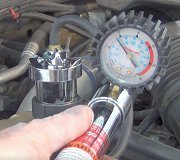All of those methods will get the job done of pumping fuel, but if you're in a crash that ruptures a fuel line you need to have an automatic way to turn the pump off so it doesn't dump fuel on the ground and create a fire hazard. You may not be physically able to do that. Chrysler has the most effective system with their automatic shutdown (ASD) relay. The Engine Computer turns that relay on for one second when the ignition switch is turned on, then again when it sees engine rotation, (cranking or running). It knows that by the pulses it receives from the crankshaft position sensor and camshaft position sensor. When the fuel line is broken, the engine stalls because it can't run with no fuel pressure. There's no pulses from the sensors, so the computer turns the ASD relay off. That removes power to the ignition coil, injectors, and fuel pump or pump relay, among a few other things. This system has been used for decades and works very well. One advantage to turning on for one second when you turn on the ignition switch is to insure the fuel pressure is up for starting in case it bled down over days or weeks.
I'm less familiar with GM's system but on some older cars they used the oil pressure switch. The thought there was if the fuel line got broken the engine would starve for fuel and stall, then the oil pressure would go down and the switch would turn the pump off. The disadvantage was there wasn't that one-second pulse to insure the pressure was up. That wasn't an issue with carbureted engines like in the Chevette, but with a ruptured fuel line, if the engine stayed running after a crash, it could take a minute or two for the engine to use up the fuel in the float bowl. Fuel would be pumped onto the ground during that time. With their fuel injected engines there is no oil pressure yet during cranking, and the stored pressure is only enough to run the engine for a few seconds, so they also turn the pump on during engine cranking. The oil pressure switch takes over when the pressure comes up. Another disadvantage is the pump may stop working if the oil pressure is low. That was a common problem with the Chevettes that caused unexplained and unexpected stalling.
The biggest issue from my point of view when giving advice or when doing this modification for myself is liability. Insurance investigators and lawyers love to find safety modifications, ... In the other guy's car. Altered ride height and anything else that changes handling and braking response are real big deals. You will want to incorporate something that insures the pump turns off if there's a fuel leak. The easiest way to do that is with the oil pressure switch. Unfortunately you will have a carburetor so as with those earlier GM vehicles, your engine could run for a couple of minutes before the engine stalls. I have never looked into this but you might research whether someone offers a fuel pressure switch. You'll have less than five pounds of pressure in the supply line. That will go to 0 pounds immediately if the line is broken. For starting you won't have any trouble because of the fuel stored in the float bowl. You won't have any fuel pressure either though so you will need a second power source tied in with the ignition switch so the pump will turn on during engine cranking. You'll need an "off" switch too to stop the pump when you turn the engine off.
Tuesday, April 23rd, 2013 AT 9:52 PM


